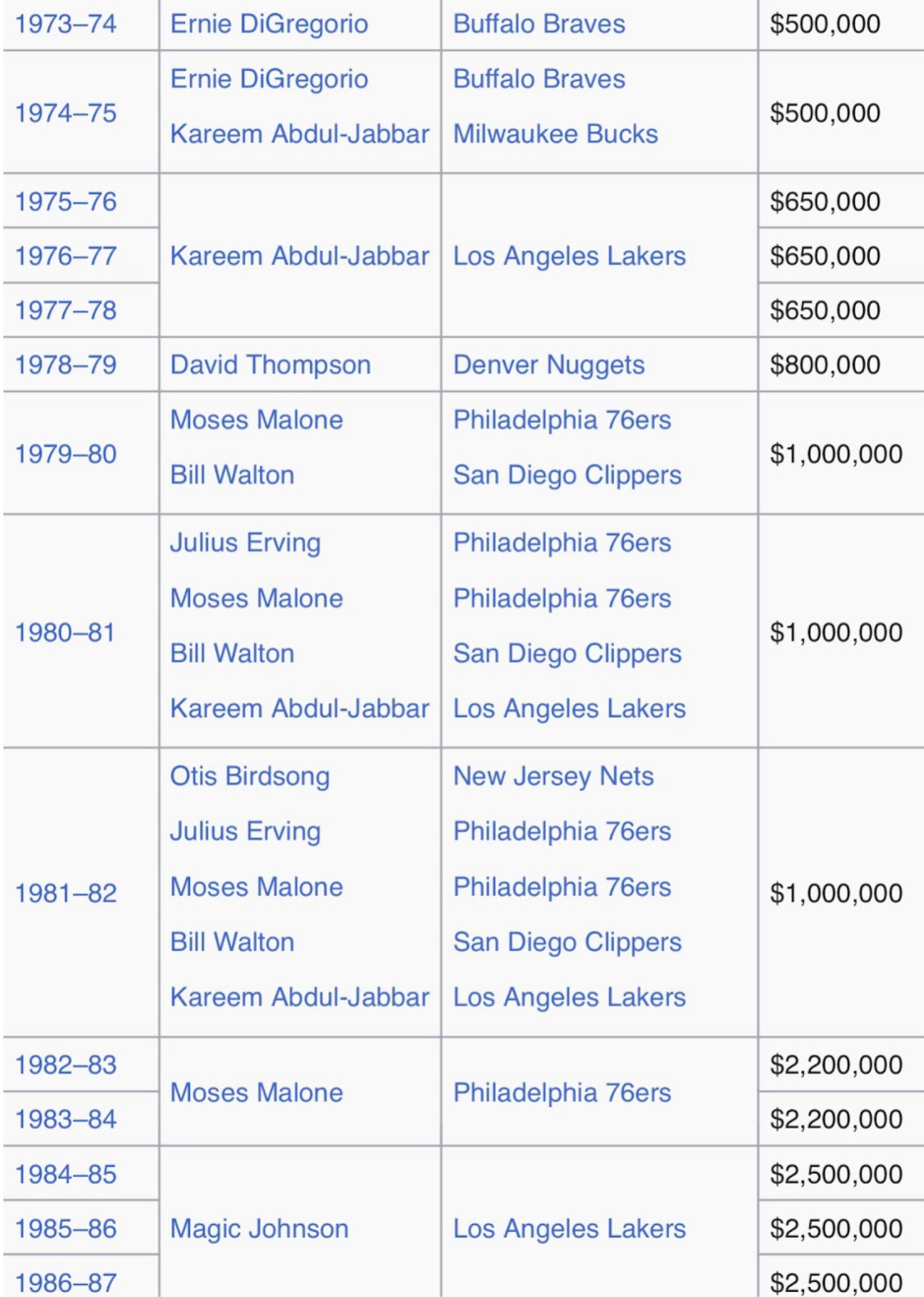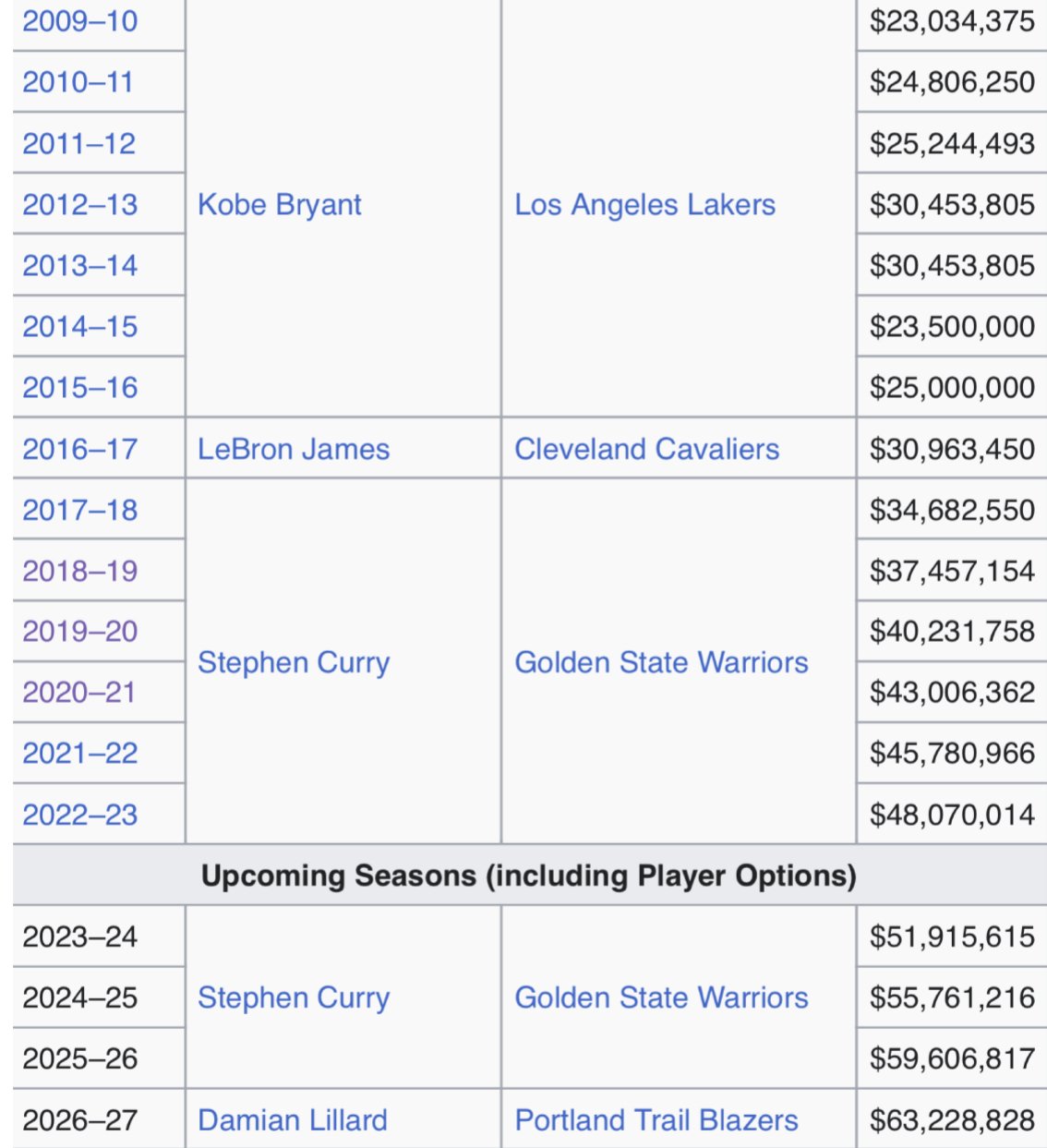How the NBA salaries grew 12,546 times over the last 50 years
Introduction
The National Basketball Association (NBA) is a world-renowned professional sports league consisting of the “major 4” sports leagues of the United States. Its sponsorship revenue streams had amounted to over 1 billion dollars for the 2022-23 campaign alone, and its biggest stars are making 8 figures at the end of each season. However, this has not always been the case for the association, as only 50 years ago, its highest earners were earning a salary over six figures. This article looks at the economic growth of the National Basketball League over the last half-century, which has subsequently led to a larger piece of the cake being taken by every party involved: players, coaches, senior executives, and even more so - the owners.
Comparing Player Salaries ( 1973-87 Vs. 2009-23)
Highest Annual Salaries year-on-year between the seasons 1973-87 | Source: Wikipedia
First, before blowing this increase way out of proportion (albeit still exponential), it is essential to consider how much 500,000 USD was back in 1973. A 500,000 Dollar check is equivalent to about 3,457,500 USD in present-day value. Meanwhile, 2.5 million Dollars in 1987 equals approximately 6,190,040 Dollars today. While on the surface, the salaries 35-50 years ago do not set an entirely proper perspective in terms of the relative growth in annual wages of the biggest stars playing in the NBA, the rise is still extremely impressive when you compare them to those of 2009 up to 2023.
Highest Annual Salaries year-on-year between the seasons 2009-23 | Source: Wikipedia
Even if you disregard the top salaries for players in the early 70s and late 80s and solely focus on the figures earned by the highest-earning players each year in the past 14 years, you would still notice a 108.7% increase in the annual salaries of the highest paid players in the NBA from Kobe Bryant of the Los Angeles Lakers making 23.03 million Dollars in 2009, to Stephen Curry of the Golden State Warriors making 48.07 million Dollars in 2023. If we were to compare the salaries of Curry in 2023 and DiGregorio in 1973, we would get a total percentage increase of 9,514%. Even if we were to convert the currency of 1973 into today’s, the increase would amount to 1,291%. The wage increase in a relatively short period is impressive, but How did the NBA manage to do this?
Brand Image and the Serge of Newundoubtedly Superstars
By the end of the 1970s, the viewership of the NBA was struggling boosted. This didn’t help the league’s turnover figures, and the talent on the NBA roster was pulling thin, with the whole club seemingly being carried by the likes of Kareem Abdul-Jabar and Moses Malone, to name a few. The league was looking like the 2nd choice to the rival association, the American Basketball Association (ABA), which was looking like it could seriously compete with the NBA, especially following its innovation of the “three-point line,” which has the process drawn even more viewers, and subsequently forced the NBA into adopting the same rule. The struggles wouldn’t last long, as two of the most exciting college prospects of all time, Larry Bird and Earvin “Magic” Johnson, were set to enter the league, which would turn around its fortunes forever. The destination of the two players couldn’t have been more conducive to rejuvenating the economic state of the League. Bird went on to represent the Boston Celtics, while Magic joined the Los Angeles Lakers—the two NBA franchises that arguably constituted the greatest rivalry in Basketball history. The reunion of the Celtics and the Lakers in the finals in 1984, 1985, and 1987, along with Bird and Magic’s phenomenally mesmerizing play, have boosted the NBA Finals viewership figures to 24.12 million viewers in 1987. This increase in popularity of the NBA brand directly resulted in the league turning a revenue of 200 million in 1987, which is 40% of the total revenue the society had generated throughout the whole of the 1970s. This avalanche of cash flowing into the company, along with the contribution of the former commissioner of the club, David Stern, would subsequently lay the significant foundations for further expansion of the league, globalization of the brand, and player empowerment, all of which have played an essential role in the further growth of the company and its finances.
Jordan Brand
Moving swiftly into the 1980s and 90s on the timeline of the NBA’s monetary growth, those decades have overseen the introduction and the dominance of arguably the greatest player ever to grace a basketball court - Michael Jordan. Although Jordan has succeeded in bringing in even more viewership and recognition to the NBA’s brand image with his sublime play, just as Bird and Magic have in the previous decades, MJ’s contribution to the NBA’s growth goes well beyond his basketball ability. Following his sensational rookie season in the league, Nike released Jordan’s first signature shoe to the market, “Jordan 1”. The color schemes of the shoe were unusual for a basketball player at the time and, at some point, did not even fit within the NBA’s uniform guidelines, which immediately sparked curiosity and interest amongst a large spectrum of demographics. The logo of Air Jordan was also revolutionary in some senses, as Michael Jordan became the “stand-alone” star of his shoe brand’s logo, which is now rightfully considered iconic in the mass media culture. As Jordan continued to amaze fans worldwide, the Jordan Brand and the NBA grew exponentially in the early 1990s, leading to all-time high viewership figures for the league. Michael Jordan became such an enormous household name across the globe that thousands of people who would usually never care for basketball would start tuning into Chicago Bulls games to see Jordan play live, hence enlarging the viewership figure even more.
Modern Era
The surge of new superstars, development of players’ brands, and outstanding leadership of commissioner David Stern, as well as the all-time high viewership figures, would result in the league’s turnover and revenues growing gigantically in the period of the past 50 years. The glaring reflection of such economic success lies beneath the difference in the salaries the league’s biggest stars received from the beginning to the end of the period. The rise in the global recognition of the NBA brand has gradually caused an increase in the total salaries of the superstars in the league. From 1 million to 20 million to 50 million, to eventually 100 million in 1996, as Juwan Howard of the Washington Bullets (now Wizards) signed a 7-year, $105 million contract, becoming the first player in the league’s history to reach the total salary mark of nine figures. Nowadays, an agreement of 100 million is considered a norm for players who aren’t even regarded as generational superstars around the league. As for the best of the best, Jaylen Brown of the Boston Celtics signed a four-year, $300 million contract extension this past summer, putting his name in the history books as the most expensive contract in the league’s history to date. One could say with great confidence that none of this would be possible without the brand recognition earned by the incredible play of legends such as Larry Bird, Magic Johnson, and Michael Jordan, to name a *very* few, who have paved the way for the future generations of basketball players to enjoy the economic benefits which they have played a crucial role in earning.
Written by Arsen Ashlayev | Proofread by Yasmin Uzykanova


